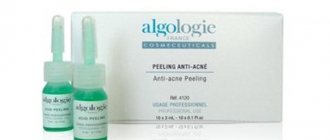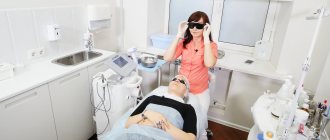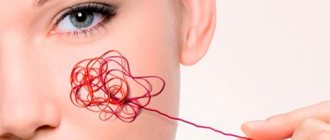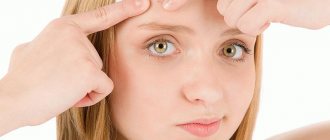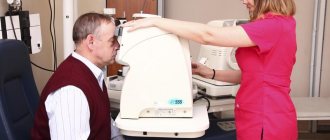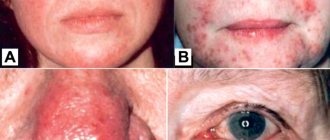| Appointment with a dermatologist at the clinic. Call a dermatologist at home. | Reception is strictly by appointment, make an appointment by phone: +7 | Prices for services | Reviews about the clinic |
Itching and redness around the eyes is an unpleasant sign, disrupting the appearance, which causes a certain amount of discomfort when visiting public places, making it possible to feel your own level of dissatisfaction with the condition of the skin.
The intensity of symptoms may be constant or appear periodically, determining seasonal allergic manifestations or the process of inflammation associated with exposure to an infectious factor. Establishing the cause of the appearance of disturbing signs on the face, affecting the eyelid area, is within the competence of the ophthalmologist, which makes it possible to determine subsequent measures for effective therapeutic recovery.
Make an appointment with a dermatologist by phone or by filling out the online form
| Select a clinic | Skin rash | Dermatologist | Dermatologist at home |
Answers to frequently asked questions about itchy skin:
- Which doctor treats itchy skin?
- What organs are affected by skin itching?
- Why is itchy skin dangerous?
- What tests should be taken for itchy skin?
- What diet is needed for itchy skin?
- What diseases does itchy skin indicate?
- Itchy skin for no apparent reason?
- What parasites cause itchy skin?
- What microorganisms cause itchy skin?
- How to get rid of itchy skin?
- Should a patient with itchy skin be isolated?
- Skin itching due to gastrointestinal diseases?
- What are the main causes of itchy skin?
- How to distinguish allergic itching from parasitic itching?
- How to prepare for an appointment with a dermatologist?
- How to get checked for skin diseases?
- What diseases does a dermatologist treat?
- What tests should be taken by a dermatologist?
- What diagnostics can a dermatologist perform in the clinic?
- Where to go with a skin disease?
Rosacea
Experts are accustomed to using the term rosacea to understand a certain clinical picture: erythema, dilated vessels, and later papulopustular rashes. However, rosacea has several degrees of development and subtypes.
Degree of development of rosacea
- Episodic erythema (rosacea—diathesis);
- I degree - ETR (persistent erythema and single telangiectasia);
- II degree - papulopustular (persistent erythema, numerous telangiectasia, papules, pustules);
- III degree - pustular nodular (persistent erythema, an abundance of telangiectasias, papules, pustules, inflammatory edematous nodes).
There are currently 4 subtypes of rosacea :
- ETR is characterized by persistent erythema of the central area of the face, occurring before or simultaneously with papulopustules (subtype II), telangiectasia, and is accompanied by a burning sensation and tingling sensation.
- PPR - persistent erythema, transient papules and pustules.
- Phymatous rosacea is a thickening of the skin with an increase in the pathologically altered area.
- Ophthalmic rosacea - dryness of the mucous membrane of the eyes, lacrimation, burning, swelling of the eyelids, recurrent inflammation and decreased visual acuity due to damage to the cornea.
Let's move on to diseases that require differential diagnosis with rosacea.
WHAT DO BAGS UNDER THE EYES TELL US?
You can be well-slept and rested, but if a person has bags under his eyes, he will still look tired and sick.
It would seem that the problem is not serious. However, bags under the eyes can signal significant health problems. Most often, swelling under the eyes is considered a sign of kidney disease, but this is not always true. There are many reasons for swelling under the eyes.
Kidney diseases
Kidney diseases are the first to be suspected, and this is no coincidence. The fact is that with serious pathologies (glomerulonephritis, severe stage of pyelonephritis, kidney tumors) protein is lost.
“With urine, the body loses a huge amount of large molecular protein compounds. That is, the kidney filter, which normally does not allow large compounds to exit with urine and retains them in the bloodstream, collapses, explains nephrologist at the Aflo-Center medical clinic network, Irina Anatolyevna Kotryakhova. “Low levels of protein in the blood cause some of the fluid to leak into the tissues.”
Renal edema usually does not occur without a large amount of protein in the urine.
Even doctors at district clinics sometimes get lost in determining whether there is “a lot or a little protein in the urine.” It happens that after medical examination the patient is urgently referred to a urologist or nephrologist to treat renal pathology. In fact, protein can be lost in small quantities for completely natural reasons. For example, if on the eve of the tests a person worked out hard in the gym. “If the daily loss of protein exceeds 3 grams per liter (this is very much) and swelling occurs, which is most pronounced in the morning, this is the kidneys. Such patients are sent to the hands of nephrologists,” says Irina Kotryakhova about the intricacies of diagnosis.
Urological patients can be seen immediately. Their face is swollen like a ball. Most often, a morning puffy look has nothing to do with kidney disease. Especially when it comes to women over 30 years old.
“As practice shows, 8 out of 10 young and middle-aged patients who complain of “bags” under their eyes are patients of plastic surgeons,” concludes Yuri Vladimirovich Goloviznin, a urologist at the Aflo-Center medical clinic network.
Heart problems
If, in addition to “bags” under the eyes, the patient is bothered by chest pain, rapid heartbeat, shortness of breath and swelling of the legs, the cause may be cardiovascular pathology. An ECG will show it first.
“In heart failure, swelling first appears in the feet and legs. If proper treatment is not carried out, they will rise higher and we will see “bags” under the eyes. But these “bags” are of a completely different kind, and not the swelling of the eyelids that we are used to seeing after sleep, explains Anton Ryabov, a cardiologist-arrhythmologist at the Aflo-Center medical clinic network. — Edema itself is not a symptom of cardiac disease. Therefore, self-diagnosis based only on “bags” under the eyes is strange, to say the least. Better yet, get some sleep. Perhaps the swelling will go away.”
Aging
A little theory. The eyeball is separated from the orbit by adipose tissue - periorbital tissue, which is held in place by a connecting membrane - the orbital septum. With age, the volume of periorbital fiber increases (for some, more, for others, less). The septum cannot withstand the pressure, and the fatty tissue extends beyond the eye sockets. Genetic predisposition plays an important role in this case.
As Igor Popov, an ophthalmologist at the Aflo-Center medical clinic network, explains, the majority of those who observe unflattering “bags” are candidates for blepharoplasty. All kinds of creams that promise instant results will not help reduce the volume of periorbital tissue.
Liver diseases
Unlike “bags,” bruises are associated precisely with a decrease in subcutaneous fat. Due to lack of sleep or sudden weight loss, the eyeballs literally fall into their sockets. This is a common and non-threatening condition. According to Zhanna Krupina, a gastroenterologist at the Aflo-Center medical clinic network, “unnatural” brownish-yellow shades should alert you. Coupled with swelling of the hands (especially fingers), heartburn, nausea and pain in the right hypochondrium, a shadow cast under the eyes may indicate liver pathology.
Edema
There are more obvious reasons for the appearance of bags under the eyes, and, as a rule, they do not go unnoticed. As Nadezhda Shubina, an allergist-immunologist at the Aflo-Center medical clinic network, explained, allergic diseases of the conjunctiva, inflammatory diseases of the paranasal sinuses, ARVI - all conditions in most cases are manifested by edema. Not to mention chronic fatigue and a severe hangover - everything is clear here.
It is important to remember: physiological “bags” under the eyes as a result of swelling are “conspicuous” after sleep and gradually fade away by the end of the day.
Pathological growth of fatty tissue does not depend on the time of day. Such “bags” do not go away after a long rest and practically cannot be corrected at home or in cosmetologist’s offices. Much less often, swelling of the eyelids is a signal of serious pathologies. But in beauty salons it is not customary to talk about this.
Drug-induced edema
Some medications also cause fluid retention in the body; most often, patients complain of side effects from oral contraceptives.
Combined hormonal contraceptives are based on two female hormones - estrogen and progesterone. The amount of estrogen is almost always the same, the only differences are in the amount of progesterone. Each patient reacts to this proportion differently.
“Differences in progesterone levels are reflected in subjective sensations. Then we select a drug with a different composition for the patient, which reduces the accumulation of fluid in the body,” says Valentina Smirnova, a gynecologist at the Aflo-Center medical clinic network.
Allergic reactions
Allergic swelling comes with the onset of spring and is usually accompanied by itching and redness. Those who have encountered this problem will not confuse such “bags” with anything else.
Thyroid diseases
Another cause of edema, according to Tatyana Sokolova, an endocrinologist at the Aflo-Center medical clinic network, is hypothyroidism. In this case, swelling appears not only under the eyes, but also on the legs, arms, and there may be swelling of the internal organs. Problems with the thyroid gland are accompanied by a number of other symptoms, and “bags” only confirm the diagnosis.
And in conclusion
In any case, you should take care of your eye health and consult a doctor at the first alarming symptoms.
In the Aflo-Center network of medical clinics, you can undergo a comprehensive examination, carry out the necessary diagnostics and treatment of existing diseases.
Make an appointment with a doctor by phone: (8332) 497-003,
Electronic registration: online.afflow.ru
Seborrheic dermatitis
Seborrheic dermatitis is a chronic inflammatory disease associated with a violation of the amount and composition of sebum and a disturbance of the skin microbiota.
Clinical manifestations : hyperkeratosis, peeling, seborrhea, inflammation and itching.
Localization : areas with the largest number of sebaceous glands, including the T-zone of the face, as well as the scalp, upper third of the back and chest area, ears.
The common feature is centrofascial erythema, the distinctive features are: with rosacea – papules and telangiectasia, with seborrheic dermatitis – the formation of scales and peeling, which are not characteristic of rosacea.
Prevention
As a rule, treatment is not required when adequate disease prevention has been established. To prevent red spots from appearing in the eye area, it is necessary to act comprehensively: make it a rule to lead a healthy lifestyle, organize yourself proper rest, as well as sleep.
It is also necessary to strengthen the body’s immune system, for which it is worth taking the necessary vitamins and minerals. Reduce mental and visual stress, walk more often. Which will lead to the disappearance of symptoms and red spots will no longer be a serious problem for you.
Acne vulgaris (acne)
Acne vulgaris usually occurs between the ages of 14 and 25, while rosacea occurs between 30 and 50 years. It is also necessary to carry out a differential diagnosis with late acne .
Common manifestations with late acne
Appearance after 40 years
Papulopustular skin rashes
Overproduction of sebum – oily skin
Possibly - prolonged exposure to the sun - a common “trigger”
Differential diagnosis
Criteria not typical for acne are diagnostic for rosacea:
Centrofascial erythema is redness of the central part of the face, which may be accompanied by subjective sensations of itching, burning or tingling. A must-have for rosacea!
Outbreaks of erythema - occur when nerve endings are irritated by provoking factors: stress, heat exposure, drinking hot and alcoholic drinks, etc.
Couperosis – appearance on the face, because the disease affects the vascular bed.
No comedones!
Anamnesis
An important part of any consultation. If the rash was present at a young age, the development of late acne is most likely.
Forms and complications
Skin manifestations of lupus erythematosus include three groups, each including specific skin manifestations:
- acute cutaneous lupus erythematosus (localized, generalized and toxic epidermal necrolysis-like);
- subacute cutaneous lupus erythematosus (ring-shaped, papulosquamous, drug-induced, erythrodermic, poikilodermic, vesiclobulous, Rowell syndrome);
- chronic cutaneous lupus erythematosus (discoid, edematous, panniculitis, pernioid, lichenoid).
The identification of these forms is due not only to the duration of the skin disease, but also reflects the connection with systemic lupus erythematosus.
Most often, the manifestation of systemic disease is acute forms, while the discoid form is observed only in 5-15% of all cases. The longer skin manifestations exist in isolation, the lower the risk of developing a systemic form of the disease. The risk of systemic disease in the presence of cutaneous manifestations is higher in women and children.
Lupus erythematosus rashes can occur in children (antibodies are passed on to the fetus) from mothers with systemic lupus erythematosus. This form is called neonatal lupus, occurs during the first two months of a child’s life and may be the first sign of systemic lupus erythematosus in the mother.
The systemic lupus erythematosus complex may also include other changes in the skin and its appendages that are not specific exclusively to this disease.
Perioral dermatitis
Synonyms: rosacea-like dermatitis, flight attendant disease - rashes around the mouth: redness, swelling and papules.
Diagnostically difficult to distinguish disease of unknown etiology. Provoking factors : the use of steroids both locally and inhaled, fluoride-containing pastes, occlusive cosmetics.
The main diagnostic differences from rosacea: bright erythema and telangiectasia are rare. Localization: nasolabial folds, perioral region, chin, lower eyelids. Women aged 20-30 years and children are affected.
Distinctive feature : rapid regression of rashes, if a trigger factor is identified.
If visual diagnosis is difficult, a histological examination is recommended.
Our advantages
"Moscow Eye Clinic" offers comprehensive diagnostics and effective treatment of eye diseases. The use of the most modern equipment and the high professional level of specialists working in the clinic eliminate the possibility of diagnostic errors.
Based on the results of the examination, each visitor will be given recommendations on choosing the most effective methods of treating the eye pathologies identified in them. By contacting the Moscow Eye Clinic, you can be sure of quick and accurate diagnosis and effective treatment.
All questions you are interested in can be asked to specialists by calling 8 (800) 777-38-81 and 8 (499) 322-36-36 or online using the appropriate form on the website.
Mironova Irina Sergeevna
